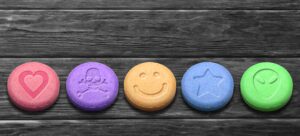Molly, commonly referred to as ecstasy or MDMA, is an illicit synthetic drug sharing chemical and pharmacological traits with stimulants and hallucinogens. It’s sought after for its ability to boost mood and heighten sensory experiences.
Despite its reputation as a relatively safe option compared to drugs like heroin or cocaine, Molly still poses risks, including the potential for overdose.
In this article, we’ll explore the signs of Molly overdose, which factors increase the risk, and what steps to take if someone overdoses.
Speak to one of our admissions counselors today by calling 888.903.9898.
What Is Molly?
Molly, a popular street name for ecstasy, contains MDMA (3,4-methylenedioxymethamphetamine) as its primary psychoactive ingredient. This compound is unique in that it exhibits characteristics of both stimulants and hallucinogens.
Typically ingested in pill form, Molly is a popular club drug. Its purity is notoriously variable, as it’s often laced with other substances such as fentanyl, PMMA (a synthetic amphetamine), or bath salts.
Effects of Molly
Molly’s effects usually kick in within 30 minutes to an hour and last three to six hours. These effects include increased energy, euphoria, mood enhancement, heightened sensitivity to touch, and distorted time perception.
Molly is thought to influence three main neurotransmitter systems:
- Serotonin: This neurotransmitter affects sensory perception, mood, and sleep. MDMA enhances serotonin activity, leading to elevated mood, increased emotional intimacy, and heightened empathy often felt after taking the drug.
- Dopamine: Responsible for activating the brain’s reward system and boosting energy levels, dopamine’s involvement in Molly usage often leads to continued consumption.
- Norepinephrine: This neurotransmitter increases heart rate and blood pressure and may contribute to some of the heightened physiological effects of taking Molly.
How Much Molly Is Too Much?
Unlike most drugs that only lead to overdose when taken in large amounts, Molly can trigger fatal reactions at any dose. With that said, toxicity is more likely with high doses. It’s also important to note that mixing Molly with other substances like alcohol or amphetamines increases the risk of overdose.
Additionally, despite not being traditionally viewed as addictive, prolonged Molly use can lead to addiction.
Molly (Ecstasy) Overdose Symptoms
The symptoms of a Molly overdose vary depending on the dose, a person’s overall health, and any other substances used. However, common overdose symptoms include:
- Dry mouth
- High or low blood pressure
- Abnormal heart rate and rhythm
- Faintness
- Panic attacks
- Nausea and vomiting
- Loss of consciousness
- Seizures
- Rigid muscles
- Elevated body temperature (hyperthermia)
- Hallucinations
- Serotonin syndrome
Molly Overdose Risk Factors
While Molly has several negative side effects on its own, other factors may increase the risk of an overdose. These include:
Using Molly with other substances: Combining Molly with alcohol, stimulants, or opioids increases the risk of dehydration, overheating, and cardiovascular issues.
“Piggybacking” or “stacking” Molly: Taking a high dose of Molly over a short period (piggybacking) or taking three or more tablets all at once (stacking) can result in high levels of ecstasy in the bloodstream, increasing the risk of toxicity.
Environmental factors: Molly is commonly found at hot, crowded events such as clubs or parties. These conditions and Molly’s physiological effects increase the risk of hyperthermia.
Is a Molly Overdose Fatal?
While uncommon, overdosing on Molly can be deadly, particularly when combined with other substances. Most Molly-related deaths result from heatstroke, serotonin toxicity, and water intoxication.
Heatstroke
Molly is often consumed in hot, crowded environments like clubs or concerts, exacerbating its physiological effects and raising body temperature to dangerous levels. Elevated body temperature can spike blood pressure and heart rate, resulting in profuse sweating, muscle spasms, and dehydration.
Serotonin toxicity
Molly prompts an excessive release of serotonin, which can lead to serotonin syndrome — a severe condition marked by sweating, confusion, tremors, muscle rigidity, and high body temperature. Those taking certain antidepressants, such as MAOIs and SSRIs, face a heightened risk when using Molly.
Water intoxication
Some people consume excessive amounts of water while taking Molly to prevent overheating. Overhydration dilutes blood sodium levels, leading to brain swelling, coma, or death. Symptoms of water intoxication include confusion, seizures, and delirium.
What to Do if Someone Overdoses on Molly
Calling 911 is the best thing to do if you suspect someone has overdosed on Molly. Report any other substances the person took when speaking with emergency responders.
While waiting for assistance, focus on lowering the person’s body temperature. Move them to a cool, shaded area away from crowds, and either mist their body with cool water or gently pat it with damp towels.
Inclusive Molly Treatment at La Fuente Hollywood
Even small doses can result in dangerous and potentially fatal effects. Moreover, regular use of Molly can lead to addiction.
If you or someone you love has recently overdosed on Molly or is struggling with Molly addiction, contact La Fuente Hollywood Treatment Center. Our Los Angeles facility offers inpatient and outpatient programs specifically designed for the LGBTQ community.
Call La Fuente at 888.903.9898.




